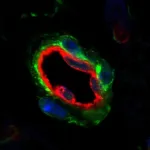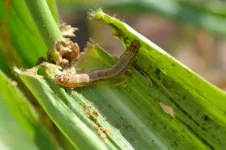(Press-News.org) DALLAS - Feb. 3, 2021 - Gaining more fat cells is probably not what most people want, although that might be exactly what they need to fight off diabetes and other diseases. How and where the body can add fat cells has remained a mystery - but two new studies from UT Southwestern provide answers on the way this process works.
The studies, both published online today in Cell Stem Cell, describe two different processes that affect the generation of new fat cells. One reports how fat cell creation is impacted by the level of activity in tiny organelles inside cells called mitochondria. The other outlines a process that prevents new fat cells from developing in one fat storage area in mice - the area that correlates with the healthy subcutaneous fat just under the skin in humans. (Both studies were done in mice.)
In the second study, a commonly used cancer drug was able to jump-start healthy fat cell creation in mice, a finding that raises the possibility of future drug treatments for humans.
While fat isn't popular, as long as people overeat they will need a place to store the excess calories, explains Philipp Scherer, Ph.D., director of the Touchstone Center for Diabetes Research at UT Southwestern and senior author of the first study focusing on mitochondria. There are two options, he says: squeezing more lipids (fat) into existing fat cells and ballooning their size, leading to problems such as inflammation and, eventually, diabetes; or creating new fat cells to help spread the load. Fat stored properly - in fat cell layers under the skin (subcutaneous fat) that aren't overburdened instead of around organs (visceral fat) or even inside organs - is the healthy alternative, he says.
Problems follow if existing fat cells are left on their own to become engorged, adds Rana Gupta, Ph.D., associate professor of internal medicine and senior author of the second study. "When these cells are so overwhelmed that they can't take it anymore, they eventually die or become dysfunctional, spilling lipids into places not intended to store fat."
Those lipids may move into the liver, leading to fatty liver disease; to the pancreas, resulting in diabetes; or even to the heart, causing cardiovascular disease, Gupta says. Visceral, or belly fat, may surround the organs, creating inflammation.
The healthiest place to store fat is in subcutaneous fat, adds Gupta. Ironically, that is where mice in his study were least able to create new fat cells, despite the fact that stem-cell-like progenitor cells primed to become fat cells were present there as well, he says.
Gupta's study identified a process that prevents progenitor cells from developing into fat cells in mouse subcutaneous inguinal fat.
The protein HIF-1a (short for hypoxia-inducible factor-1 alpha) is central to the process. It kicks off a series of cellular actions that ultimately inactivate a second protein called PPARgamma, the key driver of fat cell formation.
These proteins are found in both humans and mice. In fact, in a culture of human subcutaneous fat cell progenitors, HIF-1a also inhibited new fat cells from being created, according to Gupta.
In Gupta's mouse study, researchers used a genetic approach to inhibit HIF-1a and found that the progenitor cells could then make subcutaneous inguinal fat cells and fewer were inflamed or fibrotic.
Next, they tested the cancer drug imatinib (brand name Gleevec) and found it had the same effect. The cancer drug was tried because it was known to have beneficial effects against diabetes in cancer patients with both diseases, Gupta says.
In Scherer's study, researchers manipulated a protein called MitoNEET in the outer membrane of the precursor cells' mitochondria, organelles known as the cells' power plants. The resulting mitochondrial dysfunction and drop in cell metabolism caused precursor cells to lose the ability to become new fat cells and increased inflammation.
"This study shows we can manipulate the precursor cells' willingness to become fat cells," Scherer says. "The ability to recruit new fat cells by tickling these pre-fat cells to become fat cells is very important and has profound beneficial effects on health, particularly in the obesity-prone environment that we all live in."
He says his goal is now to design a drug that could stimulate mitochondrial activity.
"Understanding the mechanism is an important first step," Scherer says, referring to the findings from the two studies. "We will have to learn in the future how to manipulate these processes pharmacologically."
INFORMATION:
Scherer holds the Gifford O. Touchstone, Jr. and Randolph G. Touchstone Distinguished Chair in Diabetes Research, and the Touchstone/West Distinguished Chair in Diabetes Research.
Other UT Southwestern researchers who participated in Scherer's study include first author and postdoctoral researcher Nolwenn Joffin, plus Vivian A. Paschoal, Christy M. Gliniak, Clair Crewe, Abdallah Elnwasany, Luke I. Szweda, Qianbin Zhang, Christine M. Kusminski, Ruth Gordillo, Dayoung Oh, and Gupta.
UT Southwestern researchers participating in Gupta's study include first author and assistant instructor Mengle Shao, Chelsea Hepler, Qianbin Zhang, Bo Shan, Lavanya Vishvanath, Gervaise H. Henry, Shangang Zhao, Yu An, and Douglas W. Strand.
Scherer's study was supported by National Institutes of Health grants R01-DK55758, P01-DK088761, R01-DK099110, P01-AG051459, F32-DK113704, F31-DK113896, R01-DK104789, R01-DK119163, and RC2-DK118620. Joffin was supported by a postdoctoral fellowship from the Lipedema Foundation, LFA no. 18.
Gupta's study was supported by National Institute of Diabetes and Digestive and Kidney Diseases grants F31DK113696, R01 DK104789, RC2 DK118620, R01 DK119163, R01 DK115477; American Diabetes Association grant 1-17-IBS-181; American Heart Association grants 16POST26420136 and 19CDA34670007; and support from the Japan Society for the Promotion of Science's Grants-in-aid for Scientific Research (B) 18H02425.
UT Southwestern, one of the premier academic medical centers in the nation, integrates pioneering biomedical research with exceptional clinical care and education. The institution's faculty has received six Nobel Prizes, and includes 23 members of the National Academy of Sciences, 17 members of the National Academy of Medicine, and 13 Howard Hughes Medical Institute Investigators. The full-time faculty of more than 2,500 is responsible for groundbreaking medical advances and is committed to translating science-driven research quickly to new clinical treatments. UT Southwestern physicians provide care in about 80 specialties to more than 105,000 hospitalized patients, nearly 370,000 emergency room cases, and oversee approximately 3 million outpatient visits a year.
People with severe mental disorders have a significantly increased risk of dying from COVID-19. This has been shown in a new study from Umeå University and Karolinska Institutet in Sweden. Among the elderly, the proportion of deaths due to COVID-19 was almost fourfold for those with severe mental disorders compared to non-mentally ill people in the same age.
"We see a high excess mortality due to COVID-19 among the elderly with severe mental disorders, which gives us reason to consider whether this group should be given priority for vaccines," says Martin Maripuu, associate professor at Umeå University.
In the current study, the researchers studied data covering the entire Swedish population over the age of 20 during the period from 11 March to 15 June 2020. Among citizens ...
CABI scientists have updated the first major study of potential biological controls that could be used in the fight against the devastating fall armyworm in Africa. The research offers new insight into evidence of their efficacy in the field and increased availability as commercial products.
Indeed, the review, published in the Journal of Applied Entomology, includes many biocontrol products which are now featured in the CABI BioProtection Portal - a free web-based tool that enables users to discover information about registered biocontrol and biopesticide products around the world.
The fall armyworm ...
The behavior of the solvated electron e-aq has fundamental implications for electrochemistry, photochemistry, high-energy chemistry, as well as for biology--its nonequilibrium precursor is responsible for radiation damage to DNA--and it has understandably been the topic of experimental and theoretical investigation for more than 50 years.
Though the hydrated electron appears to be simple--it is the smallest possible anion as well as the simplest reducing agent in chemistry--capturing its physics is...hard. They are short lived and generated in small quantities and so impossible to concentrate and isolate. Their structure is therefore impossible to capture with direct experimental observation such as diffraction methods or NMR. Theoretical modelling has turned out to ...
An international research team including members from The University of Manchester has shown that a rapidly rotating neutron star is at the core of a celestial object now known as PSR J2039?5617
The international collaboration used novel data analysis methods and the enormous computing power of the citizen science project Einstein@Home to track down the neutron star's faint gamma-ray pulsations in data from NASA's Fermi Space Telescope. Their results show that the pulsar is in orbit with a stellar companion about a sixth of the mass of our Sun. The pulsar is slowly but surely evaporating this star. The team also found that the companion's orbit varies slightly and unpredictably over time. Using their search ...
Consider for a moment a tree swaying in the wind. How long does it take for the movement of a twig to reach the trunk of the tree? How is this motion actually transmitted through the tree? Researchers at the University of Freiburg are transferring this kind of question to the analysis of proteins - which are the molecular machinery of cells. A team of researchers lead by Prof. Dr. Thorsten Hugel of the Institute of Physical Chemistry, and Dr. Steffen Wolf and Prof. Dr. Gerhard Stock of the Institute of Physics are investigating how the signals that cause structural changes in proteins travel from one site to another. They are also trying to ...
Washington, DC / New Delhi, India - Researchers at CDDEP have released, The State of the World's Antibiotics in 2021, which presents extensive data on global antimicrobial use and resistance as well as drivers and correlates of antimicrobial resistance, based on CDDEP's extensive research and data collection through ResistanceMap, a global repository that has been widely used by researchers, policymakers, and the media.
Since the first State of the World's Antibiotics report in 2015, antimicrobial resistance has leveled off in some high-income countries but continues to rise in many low- and middle-income countries (LMICs), where access to antibiotics has risen with increases in gross ...
Researchers have found new evidence that global warming is affecting the size of commercial fish species, documenting for the first time that juvenile fish are getting bigger, as well as confirming that adult fish are getting smaller as sea temperatures rise. The findings are published in the British Ecological Society's Journal of Applied Ecology.
The researchers from the University of Aberdeen looked at four of the most important commercial fish species in the North Sea and the West of Scotland: cod, haddock, whiting and saithe. They found that juvenile fish in the North Sea and on the West of Scotland have been getting bigger while adult fish have been getting smaller. These changes ...
The world's largest bird, the ostrich, has problems reproducing when the temperature deviates by 5 degrees or more from the ideal temperature of 20 °C. The research, from Lund University in Sweden, is published in Nature Communications.
The results show that the females lay up to 40 percent fewer eggs if the temperature has fluctuated in the days before laying eggs. Both male and female production of gametes is also negatively affected.
"Many believe that ostriches can reproduce anywhere, but they are actually very sensitive to changes in temperature. Climate change means that temperatures will fluctuate even more, and that could be a challenge for the ostrich", says Mads Schou, researcher at Lund ...
Mothers are at increased risk of mental health problems as they struggle to balance the demands of childcare and remote working in COVID-19 lockdowns, according to new research from an international team of researchers.
The findings, published in the journal Psychological Medicine, were drawn from a comprehensive, online survey of mothers in China, Italy and the Netherlands.
Changes to their working lives, family strife and loss of social networks emerged as common factors affecting the mental health of mothers in all three countries.
The study was carried out by a team from Radboud University, ...
Scientists from MIPT, Moscow Pedagogical State University and the University of Manchester have created a highly sensitive terahertz detector based on the effect of quantum-mechanical tunneling in graphene. The sensitivity of the device is already superior to commercially available analogs based on semiconductors and superconductors, which opens up prospects for applications of the graphene detector in wireless communications, security systems, radio astronomy, and medical diagnostics. The research results are published in a high-rank journal Nature Communications.
Information transfer in wireless networks is based on transformation of a high-frequency continuous electromagnetic wave into a discrete sequence of bits. This technique is known as signal modulation. ...





